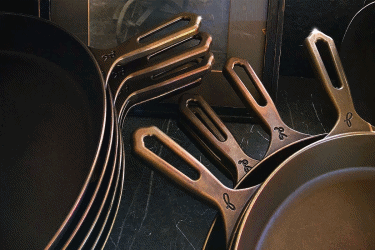The Case of the $100,000 Cast-Iron Pan
Butter Pat Industries, Cast Iron Cookware, Cuisine, Griswold Cast Iron

Butter Pat cast iron skillets.
Alex Lauer, at Inside Hook, tells us about a new company bringing old-time quality products back to life.
Founder Dennis Powell spent six figures trying to make a cast-iron skillet that was just like the ones they made 100 years ago; he originally did it just for fun and had no interest in starting a business; now that he is in business, he has no interest in growing, and as he told me on a phone call, he has no problem roasting his customers who mistreat their pans. I can already hear Mark Cuban saying, “I’m out!”
By all modern standards of business, Powell has done everything wrong. But since 2013 when he founded the company, his skillets have become a favorite of chefs when cooking at home, received the highest marks of any cast iron that’s undergone the rigorous testing at Consumer Reports, and regularly rack up significant waiting lists despite being some of the most expensive on the market.
So what’s going on here? It all started with his grandmother’s pan.
“The precipitating moment was: I was at home cooking, I dropped my grandmother’s pan, which was the only pan that I usually cooked with, I broke it — a great big crack in it,” Powell tells InsideHook of his favorite cast-iron skillet. “And since I’d always assumed that was going to be something I was going to give to my two kids, and I realized I wasn’t going to be able to do that, I decided that I was going to just replicate that pan, almost the way a sculptor goes about saying that they’re going to cast a bronze edition of a sculpture.”
What happened next was the slow boil of an obsession. He spent time researching in the Library of Congress, he pored over all the records from the Griswold foundry which he got from a friend who was president of the Wagner and Griswold Society, and he eventually visited 20-odd foundries in the U.S. to try and find one that could make a pan to his specifications. The walls of the skillet had to be thinner than modern iterations (3/32 of an inch thick), the cooking surface had to be smoother (a roughness average of 90) and it had to be made in the States.
“Every one of those foundries would say, ‘You can’t make cast iron to these specifications,’” he remembers. But at these meetings, along with his design brief, he also carried a century-old skillet from Favorite Stove & Range Company that had inspired his own design. “Then I would pull the pan out and say, ‘Well where did this pan come from?’”
After a good long while — which included some test castings at an Amish foundry in Pennsylvania that specializes in replacement parts for steam engines — what Powell discovered is that people don’t make them like they used to because modern technology has made it untenable; automatic molding machines are the norm, not hand-casting done one at a time.
“It wasn’t until 2015 when my wife said, you know you realize you have $100,000 tied up in your research — without exaggeration — and you ought to try to monetize this,” he says. But he was at a fork in the road. On one hand, he could do things like other modern cast-iron companies — brands like Finex, Field Company and Smithey — by creating a rough cast and then mechanically smoothing the pans, or he could develop a brand-new process from scratch that replicates cast iron of the late 1800s in the 21st century.
He chose the latter, and he succeeded.
The problem is their 12-inch “Joan” skillet costs $295, and you can buy a 100+-year-old equivalent Griswold made in Erie, Pennsylvania for less.
Griswold Manufacturing Wikipedia article
Griswold history and guidebooks
Another Griswold guide
Why? The old Griswold cast iron pans are much, much lighter, and their cooking surface is smoother which means they cook better with less sticking.



